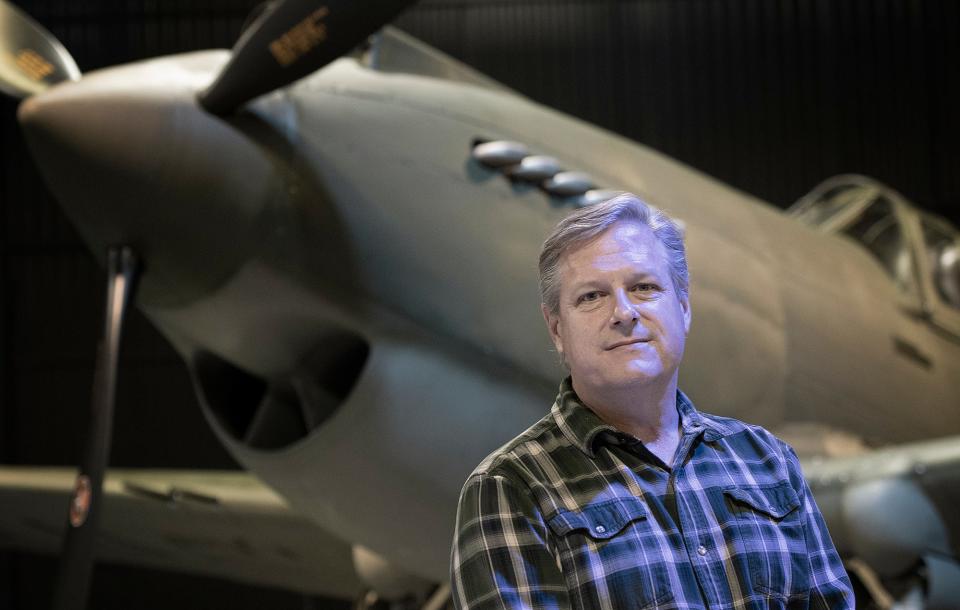80 years after attack on Pearl Harbor, fighter plane in Hudson is link to time of conflict
HUDSON — As the bombing of Pearl Harbor reaches its 80th anniversary, and fewer witnesses remain alive to tell the story, items like the last flying fighter plane from Pearl Harbor serve as a bridge to a time of conflict that shook the world.
On Dec. 7, 1941, the Japanese launched a surprise on the naval base of Pearl Harbor in Honolulu. The attack killed 2,403 Americans including 68 civilians. Another 1,178 were wounded.
While countless planes and ships were destroyed in the attack, one fighter plane began a journey more than half-way across the Earth, eventually ending up in the American Heritage Museum in Hudson at 568 Main St.
The plane is a Curtiss P-40B Tomahawk fighter plane owned by the Collings Foundation. It is the last fully restored and flying fighter plane that survived the attack that spurred the United States into entering World War II.
Two known Central Massachusetts residents were among those who died. One was Buglemaster 2nd Class Lionel W. Lescault, a Spencer native who was living in Worcester when he enlisted, and the other was Seaman First Class Maurice Mastrototaro of Worcester. Lescault was on the deck of the USS Oklahoma at the time of the attack. Mastrototaro served aboard the USS Curtis.

'Twist of fate' spares the P-40B
The P-40B was built in Buffalo, New York in 1940 and was attached to the 19th Pursuit Squadron of the 18th Pursuit Group at Wheeler Field on O'ahu, Hawaii. The 18th Pursuit Group sustained extensive losses in the attack with the only two planes in the squadron to get off the ground being shot down.
The plane at the museum was grounded on that infamous day, which Hunter Chaney, director of marketing for the American Heritage Museum, said could have been the reason why the P-40B made it out of the attack in one piece.
The aircraft was undergoing repairs in a hangar at the time of the attack. The collapsed hanger protected the plane, which survived intact.
"That seemingly minor twist of fate most likely saved the aircraft from being destroyed," Chaney said.
Not too long after, the aircraft crashed into the side of a mountain in Hawaii.. On Jan. 24, 1942, the plane spun out of control. The pilot, 1st Lt. Kenneth W. Sprankle, 27, of Pennsylvania, was killed in the crash.
The P-40B was not rediscovered until 1985. Over the next four years, the airframe and other parts were recovered.
Plane's restoration
After being returned to the United States, a restoration by the Curtiss-Wright Historical Association commenced. Using as many original parts as possible, including those from other planes that crashed in 1941, the P-40B was rebuilt from the ground up.
Over the course of 25 years, the P-40B was restored to flying conditions.
After being restored, the plane took a trip in 2003 to Duxford, United Kingdom, where it joined "The Fighter Collection" at Duxford Aerodrome.
The American Heritage Museum acquired the airplane in 2013. The plane had been kept at Worcester Regional Airport until two years ago, when it was brought to Hudson and included in the museum's collection.
Tactile connection to WWII
The P-40B is one of 29 warplanes of different eras in the collection, which also includes a large number of tanks and other military items and a large classic car collection.
"It remains a real iconic aircraft to engage people, specifically in the Pacific campaign in World War II," Chaney said.
With the generation that fought and lived through World War II having largely passed on, Chaney said that artifacts like the P-40B play a role in being a tactile connection to that time in history and a continued reminder to take the lessons from that era to heart.
"World War II is the worst, most horrific conflict that humans have ever had to endure while we're on this small blue marble in space. In the realm of history, 80 years ago is still not that far away," Chaney said. "There's a saying that is well known that, 'Those who forget history are doomed to repeat it.' World War II is certainly something that we would never ever want to to repeat. So the lessons learned from World War II are extremely relevant to today."
The P-40B design is a modification from the Curtiss P-36 Hawk, Chaney said. The aircraft is considered one of the earliest versions of an attack bomber from World War II and was used by most Allied forces including the British Royal Airforce. The planes were also key in the United States' Lend-Lease program with China, where China was granted the planes for use during the war.
Chaney said that he is not aware if any of the increasingly small number of the remaining Pearl Harbor survivors include a New England resident.
This article originally appeared on Telegram & Gazette: 80 years after attack on Pearl Harbor, fighter jet in Hudson is link to time of conflict

